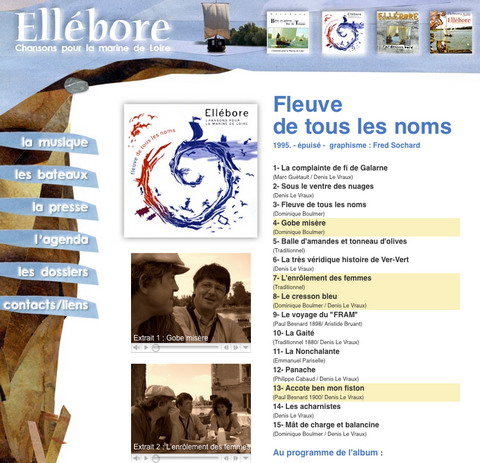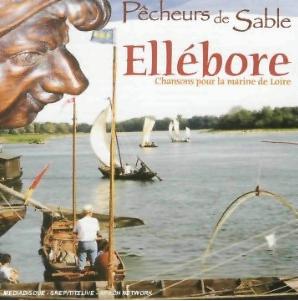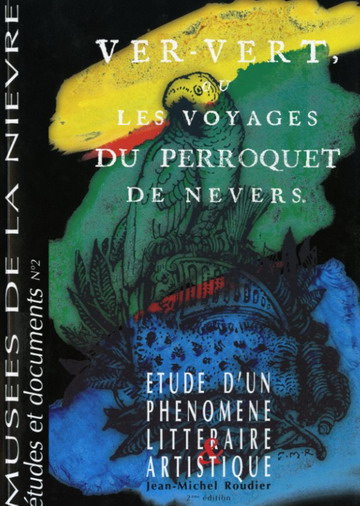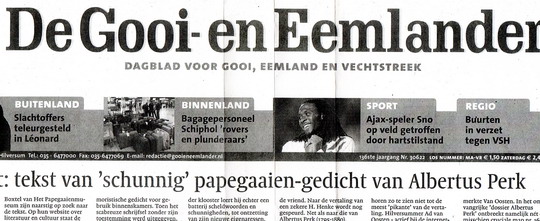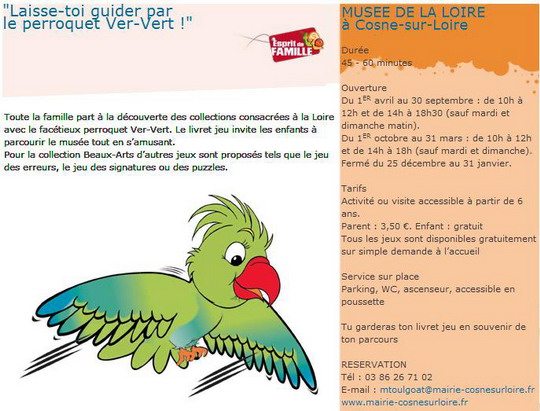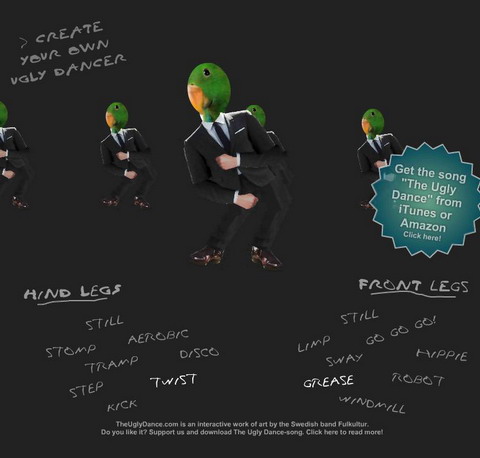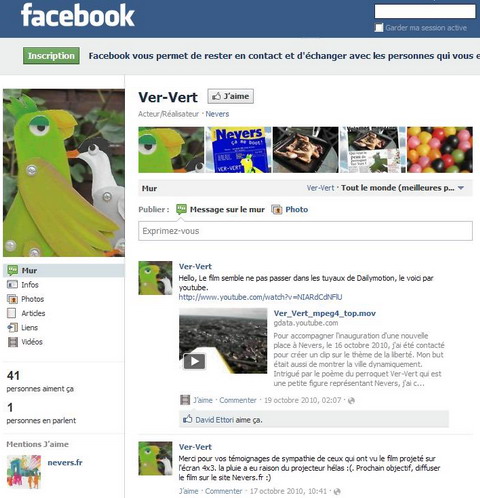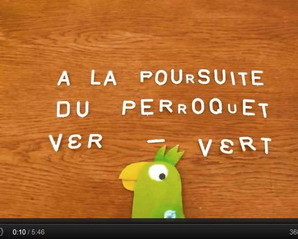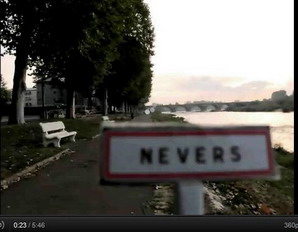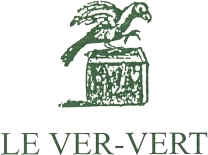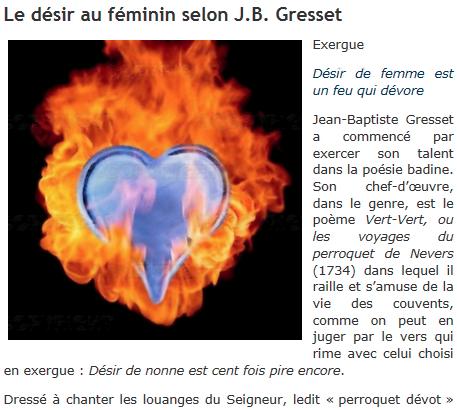Pour accompagner
l'inauguration d'une
nouvelle place à Nevers,
le 16 octobre 2010, j'ai
été contacté pour créer
un clip sur le thème de
la liberté. Mon but
était aussi de montrer
la ville dynamiquement.
Intrigué par le poème du
perroquet Ver-Vert qui
est une petite figure
représentant Nevers,
j'ai choisi d'articuler
mon film autour de ce
personnage.
Au travers d'une
figurine en carton peint,
je lui ai redonné sa
notoriété fugace, le
temps d'une
course-poursuite
frénétique. Je l'ai
imaginé en people
célèbre traqué par
quatre sales gosses (mes
enfants :) et contraint
de se cacher pour vivre
tranquille: la liberté,
quoi...
La frénésie est
accentuée par la
technique de la
pixilation, c'est à dire
la prise de vue image
par image, avec un
appareil photo, et par
une bande son electro
que j'ai eu l'audace de
réaliser aussi.


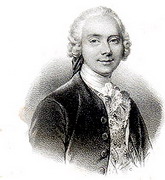
|
Inhoud
HPM
|
|
1995 Ellébore
|
Schipperslied van de Loire over La très véridique histoire de Ver-Vert Tekst en muziek: Denis Le Veaux Uitvoering: Ellébore Album: Fleuve de tous les noms (1995) (épuisé)
|
Het lied komt ook voor op het album Pêcheurs de sable van Ellébore (#18) Bron: http://www.ellebore.org/
|
|
2002 Jean-Michel Roudier |
catalogus van een tentoonstelling in het Musée de la marine de Loire, Chateauneuf-sur-Loire
|
Jean-Michel Roudier, Ver-Vert, ou les voyages du perroquet de Nevers, Musées de la Nièvre, 2003 |
|
2008 Parroting and the Periodical: Women’s Speech, Haywood’s Parrot, and its Antecedents Door: Manushag N. Powell Tulsa Studies in Women's Literature, Volume 27, Number 1, Spring 2008, pp. 63-91 (Article) Published by The University of Tulsa |
Het amoureuze leven van Ver-Vert In a variation on this theme, in the adaptation of one of Pétis de la Croix’s Persian Tales that appears in Spectator 578, the unfortunate Fadlallah is turned into his wife’s pet nightingale and must watch helplessly from his cage every night as his rival makes love to her. 30 In Jean Baptiste Louis Gresset’s popular French poem, "Ver-Vert: or, the Nunnery Parrot" (1734, translated into English in 1759), Ver-Vert (sometimes "Green-Green" in the English), an Indian parrot sent from his home to a convent in Nevers "for his good" is described as the rooster among his hens. 31 The parrot is "debonair, / Light, spruce, inconstant, gay, and free" (p. 10, ll. 114-15), all the nuns adore him wildly, as the "Sole licens’d male to be belov’d" (p. 10, l. 133) among them, and he has complete freedom to roam the nunnery, receiving lots of tasty treats and caresses, and pecking the nuns "in wanton play" (p. 11, l. 145). "No human Parrot of the court / Was fondled half so much as he" (p. 13, ll. 180-81); he even spends every night in the chamber of a different nun. 32 Another example of sex and parrots appears in the frame story of Alexander Dow’s Tales, Translated from the Persian of Inatulla of Delhi (1768). Prince Jehandar’s best friend, Jewan Sadit, is mauled by a tiger and dies, only to be reincarnated as a parrot, who, encountering his prince, "began, as it fluttered with joy, to nibble at the roses of his lips," and, upon heading home with Jehandar, engages victoriously in a battle with the Prince’s mistress for control over his affections. 33
NOTEN 30 Suitably, in the version of this story that appears in the Tuti-nama (the Tale of the Raja, on Night 46), the young man eventually possesses the body of a parrot, and is thus able to communicate the situation to his wife and avert the tragic ending of the wife’s violation and suicide in Fadlallah’s tale. In her Adventures of Eovaai, Princess of Ijaveo, ed. Earla Wilputte (1736; rpt., Peterborough, ON: Broadview Press, 1999), Haywood inverts this story in the tale of Atamadoul, who is punished for desiring the evil Ochihatou (Haywood’s satirical Walpole character) by being changed into a monkey and chained to his bed, where she is forced to watch him grant to other women the favors she can no longer enjoy, while at the same time fending off an amorous baboon. 31 Jean Baptiste Louis Gresset, "Ver-Vert: or, the Nunnery Parrot: An Heroic Poem in Four Cantos" (London: R. and J. Dodsley, 1759), p. 10, l. 111. Subsequent references will be cited parenthetically in the text. 32 The text seems to be playing with the long-standing association between convents and pornographic fantasy. 33 Alexander Dow, Tales, Translated from the Persian of Inatulla of Delhi, 2 vols. (London: T. Becket and P. A. de Hondt, 1768), I, 16. The prince erotically reciprocates the parrot’s feelings: he "stroaked his glossy feathers and kissed his crimson bill; while the grateful bird nestled in his bosom, exhibiting every sign of delight" (I, 21). |
|
|
Eddie de Paepe in De Gooi- en Eemlander - 14 september 2010 |
Op zoek naar Albertus Perk HILVERSUM - De 19e-eeuwse Hilversumse notaris Albertus Perk was een hardwerkend en godvruchtig mens. Maar hij maakte ook een vertaling van een 'schunnig’ Frans gedicht over een papegaai, dat van de aardbodem verdwenen lijkt. Ed Schilders en Harry van Boxtel van Het Papegaaienmuseum zijn naarstig op zoek naar de tekst. Op hun website over literatuur en cultuur staat de papegaai centraal. Het tweetal heeft al een uitgebreid dossier samengesteld over het gedicht 'Vert-Vert' (Groentje) van Jean-Baptiste Gresset (1709-1777). Deze Franse jezuïet schreef het humoristische gedicht voor gebruik binnenskamers. Toen het scabreuze schrijfsel zonder zijn toestemming werd uitgegeven, moest hij de orde verlaten. Het gedicht verhaalt van de lotgevallen van een papegaai die door nonnen wordt opgevoed en dus louter godvruchtige taal uitslaat. Onderweg naar een ander klooster leert hij echter een batterij scheldwoorden en schunnigheden, tot ontzetting van zijn nieuwe eigenaressen. Van de drie Nederlandse vertalingen is slechts die van de Prudens van Duyse beschikbaar. 'Pots duizend seldermenten' is daarin een van de minste scheldwoorden van de gevederde vriend. Naar de vertaling van een zekere H. Henken wordt nog gespeurd. Net als naar die van Albertus Perk (1795-1880). De necroloog van de bekende notaris, raadslid, wethouder, erfgooiers-voorman én naamgever van de plaatselijke historische kring citeert slechts diens allerlaatste strofen. En die behoren zo te zien niet tot de meest 'pikante' van de vertaling. Hilversummer Ad van Oosten - actief bij de internet-groep De Navorser - is door Het Papegaaienmuseum bij de zoektocht naar de tekst van Perk ingeschakeld. Het spoor loopt evenwel vooralsnog dood in het streekarchief in Hilversum, zo merkte Van Oosten. In het omvangrijke 'dossier Albertus Perk' ontbreekt namelijk nét de misschien cruciale map nr. 160. Daarin zou het spoorloze gedicht best eens kunnen zitten. |
Met dank aan Ad van Oosten Op de oproep zijn nog geen reacties binnengekomen. |
|
2010 Internet |
Ver-Vert gids voor kinderen in Musée de la Loire
|
|
|
2011, 21 april Weblog |
Perversions in the Catholic church:
Presenting you Ver-Vert, The Sensual Parrot from 1734 |
Met dank aan Jos Swiers |
|
2011, 15 oktober Ver-Vert doet de Ugly Dance created by Jos Swiers |
|
|
|
2011, 11 november Ver-Vert op Facebook - videoclip van Cyrille Berger |
Animatiefilm op Facebook France
Cyrille Berger: |
Bron:
|
|
2011, 12 november Ver-Vert als collage op VuVox
|
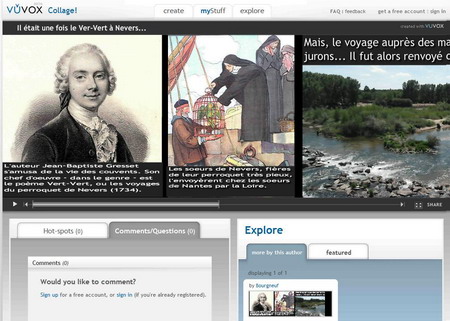 |
|
|
2011, 12 november Ver-Vert op website Nevers
|
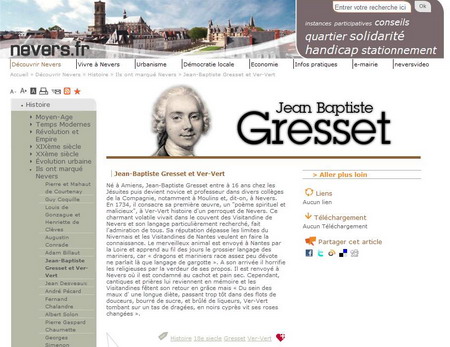 |
|
|
2011, 25 november Internet |
Boekhandel / Librairie Ver-Vert
37, rue Delambre, Paris |
|
|
2011, december
|
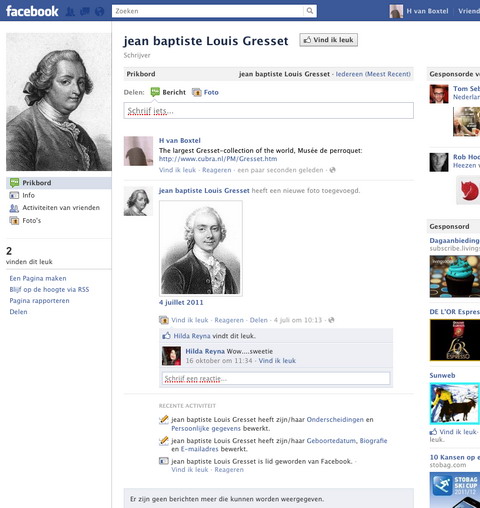 |
|
|
2012 januari Gazette d'Orléans
|
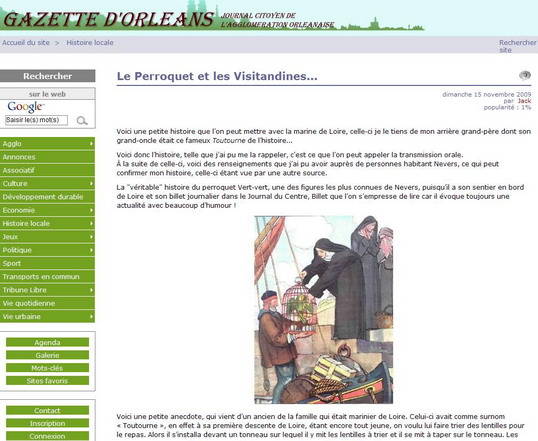 |
|
|
2013 Van een blog |
|
|
|
|
||
